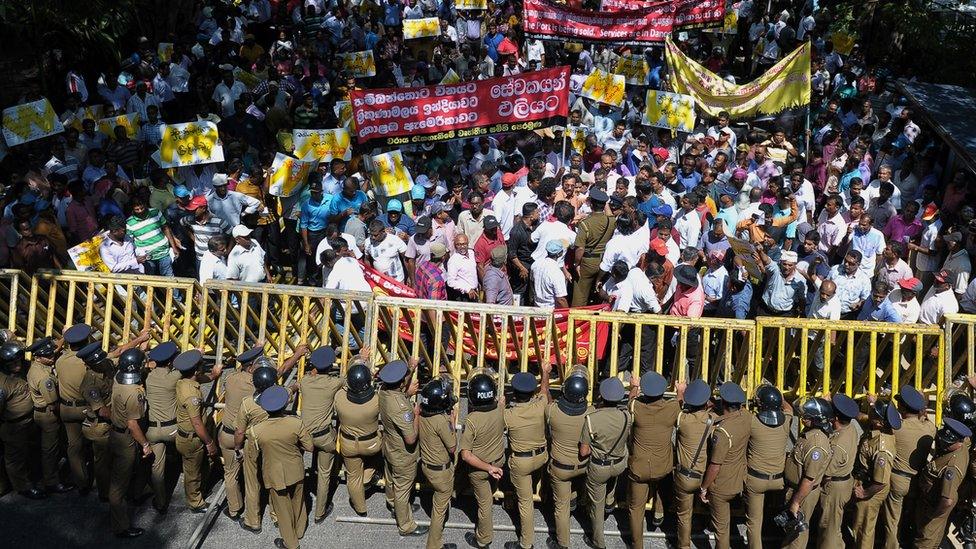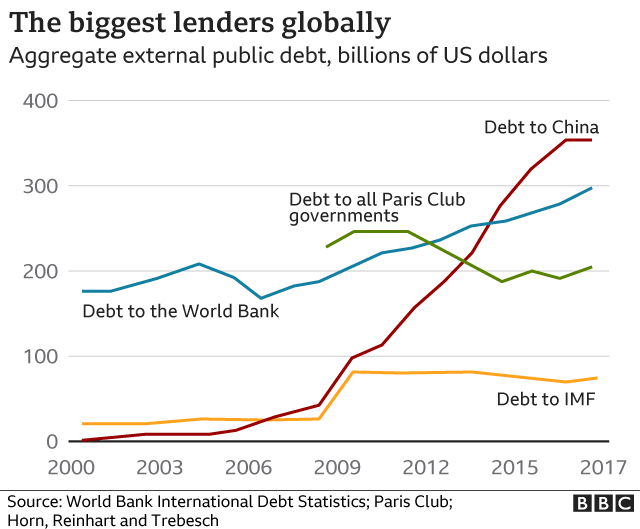China: Is it burdening poor countries with unsustainable debt?
- Published

China's lending for construction projects around the world has proved controversial
China has faced criticism for its lending practices to poorer countries, accused of leaving them struggling to repay debts and therefore vulnerable to pressure from Beijing.
But that is rejected by China, which accuses some in the West of promoting this narrative to tarnish its image.
It says: "There is not a single country that has fallen into [a] so-called 'debt trap' as a result of borrowing from China."
What do we know about China's lending?
China is one of the world's largest single creditor nations.
Its loans to lower and middle-income countries have tripled over the past decade, reaching $170bn (£125bn) by the end of 2020.

However, China's overall lending commitments are likely to be significantly greater than these figures suggest.
Research by AidData, an international development body at William & Mary University in the US, finds that half of China's lending to developing countries is not reported in official debt statistics.
It is often kept off government balance sheets, directed to state-owned companies and banks, joint ventures or private institutions, rather than directly from government to government.
There are now more than 40 low and middle-income countries, according to AidData, whose debt exposure to Chinese lenders is more than 10% of the size of their annual economic output (GDP) as a result of this "hidden debt".
Djibouti, Laos, Zambia and Kyrgyzstan have debts to China equivalent to at least 20% of their annual GDP.
Much of the debt owed to China relates to large infrastructure projects like roads, railways and ports, and also to the mining and energy industry, under President Xi Jinping's Belt and Road Initiative.
What are 'debt traps' and what's the evidence for them?
In an interview with the BBC, Richard Moore, the head of Britain's foreign intelligence agency MI6, said China uses what he called "debt traps" to gain leverage over other countries.
The claim is that China lends money to other countries, which end up having to cede control of key assets if they can't meet their debt repayments - an accusation that's been long denied by Beijing.
One example often cited by critics of China is Sri Lanka, which years ago embarked on a massive port project in Hambantota with Chinese investment.
But the billion dollar project using loans and contractors from China became mired in controversy, and struggled to prove viable, leaving Sri Lanka saddled with growing debts.
Finally, in 2017, Sri Lanka agreed to give state-owned China Merchants a controlling 70% stake in the port on a 99-year lease in return for further Chinese investment.

Sri Lankans protest against a proposed Chinese company stake in Hambantota port (2017)
Analysis of the port project by UK-based think tank Chatham House has questioned whether the "debt trap" narrative strictly applies, external, given that the deal was driven by local political motivations, and that China never took formal ownership of the port.
It points out that a large proportion of Sri Lanka's overall debt was owed to non-Chinese lenders, and that there's no evidence China has taken advantage of its position to gain strategic military advantage from the port.
Despite that, there's little doubt China's economic involvement in Sri Lanka has grown in the past decade, and concerns persist that this could be used to advance its political ambitions in the region.
There are other parts of the world where Chinese lending has also proved controversial, with contracts whose terms could give China leverage over important assets.
But there are no cases, among the hundreds of loan arrangements studied by AidData and some other researchers, of Chinese state-owned lenders actually seizing a major asset in the event of a loan default.
How does China's lending compare with others?
China does not publish records of its foreign loans, and the majority of its contracts contain non-disclosure clauses which prevent borrowers from revealing their contents.
It argues that such confidentiality is common practice, external for international loan contracts.
"Confidentiality agreements are very common in international commercial loans", says Professor Lee Jones at Queen Mary University of London.
"And much of China's development financing is fundamentally a commercial operation."
Most of the major industrialised nations share information about their lending activities through membership of what's known as the Paris Club.
China has chosen not to join this grouping, but using available World Bank data, the rapid growth in China's reported lending compared to others can be clearly observed.

Are Chinese loans harder to repay?
China tends to lend at higher rates of interest than western governments.
At around 4%, these loans are close to commercial market rates and about four times that of a typical loan from the World Bank or an individual country such as France or Germany.
The required repayment period for a Chinese loan is also generally shorter - less than 10 years, compared to around 28 years for other lenders' concessional loans to developing countries.

Interest rates on Chinese loans are higher than those from some other lenders
Chinese state-owned lenders also typically require borrowers to maintain a minimum cash balance in an offshore account to which the lender has access.
"If a borrower fails to repay its debt," says Brad Parks, Executive Director of AidData, "China can simply debit funds from [this] account without having to collect on bad debt through a judicial process."
This approach is rarely seen in loans issued by western lenders.
There's currently an initiative by G20 nations - those countries which have the largest and fastest-growing economies - to offer debt relief for poorer countries to help them deal with the impact of the pandemic.
China has joined this and says it has contributed "the highest amount of debt repayment" of any country taking part in the plan.
The World Bank says that since May 2020, a total of more than $10.3bn has been delivered in debt relief by G20 countries under this scheme.
But when we asked the World Bank for a breakdown by country, it said it could not share the information.
